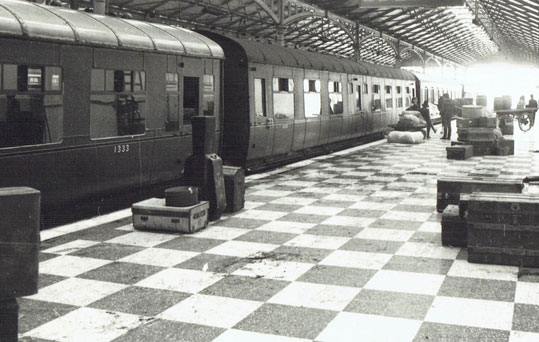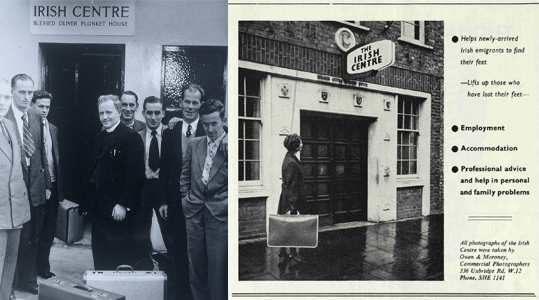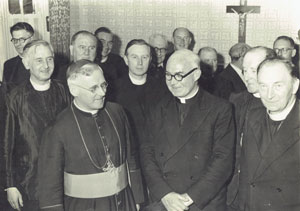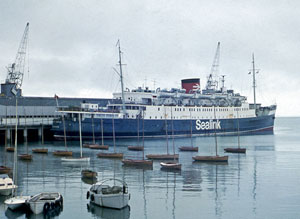SERVICES FOR 1950S IRISH EMIGRANTS—BATTLEGROUND FOR CHURCH, STATE AND COMMUNISM
Published in Features, Issue 6 (November/December 2022), Volume 30By Brian Harvey
Every year, the minister for finance steps up in the Dáil to announce the budget. Buried deep within is normally a grant to fund Irish emigrant services overseas (€12.6m in 2021). Examination of the development of these services in Britain shows some strange intrigues at their heart and challenges some of the conventional wisdom as to how they evolved, especially the role of Archbishop John Charles McQuaid’s Catholic Church.
The Republic of Ireland’s population is now 5m, so it is hard to believe that it was only 2.8m in 1961. An average of no less than 40,000 people left each year over 1951–5, 80% going to Britain, mainly London and Birmingham. Long before, the alarm bells had been ringing in Archbishop’s House in Drumcondra, Dublin. In 1942, McQuaid—in the post for less than two years—set up a new bureau for emigrants in Dublin. By 1946 it had assisted 16,000 by meeting them from the country trains, arranging overnight hostel accommodation in Dublin, directing them to Catholic associations abroad and having them met there on arrival. The next year he wrote to Taoiseach Eamon de Valera to express alarm at ‘the continuous drain on the womanhood and future motherhood of the country’. His appeal unanswered, McQuaid soon realised the futility of addressing the problems of emigrants only at only one end—the ‘sending’, Irish end—while ignoring the other, ‘receiving’, British end. His hand was forced by constant appeals from the clergy there for an expansion of their work in assisting Irish emigrants, especially the key destinations of London and Birmingham.

Above: Dublin’s Kingsbridge (now Heuston) Station in the 1950s—a transit point for tens of thousands of Irish emigrants.
LONDON
On 29 February 1948, Fr Ambrose Woods of Southwark convened a meeting of Irish priests in London, held on 4 March. Two months later, 70 Irish priests met in Westminster cathedral hall to discuss how best to improve services for Irish emigrants, being given initial financial assistance (£500) from Cardinal John D’Alton of Armagh. The priests asked the Irish government for funding through its high commission in London, seeking a loan to start a welfare centre. A hostel for men was opened in 1953, and for women in 1954. Archbishop McQuaid had in mind something much more ambitious, a proper ‘centre’ for the Irish community in London, and in 1955 the hierarchy agreed on such a centre to ensure that emigrants ‘lead a good life, go to mass, stem the leakage of the Irish from the church, stir up their faith, win back the lapsed, strengthen the wavering and encourage the good to be apostolic’. Eventually in 1960 this became the Irish Centre on Camden Square, being handed over in 1967 to the Oblate religious order, formally the Oblates of Mary Immaculate (OMI), an order originating in early nineteenth-century France and which already worked with Irish emigrants in Britain. The Irish Centre was run by a series of priest directors for the rest of the century, the building extended by a huge, debt-burdening social hall in the 1980s.
Perhaps the most remarkable feature of these years was the refusal of the Irish government to provide any support. From 1948 the Irish Centre asked, begged and implored the government to accept some responsibility for Irish emigrants, starting a voluminous paper trail. Although it got meetings with ministers and had contact with the taoisigh of the period (de Valera, Costello, Lemass, Lynch, Cosgrave)—and ministers were more than happy to visit and be photographed there—it was fobbed off with delays and excuses (‘not our job to help mendicants hanging around Irish centres in England’; ‘as soon as the boat leaves harbour, outside my responsibility’). The first grant did not arrive until Christmas 1980, 32 years later.

Above: A priest with immigrants outside the London Irish Centre in 1954 and (right) one of its flyers. (London Irish Centre)
BIRMINGHAM
By 1961, Irish people comprised 5.2% of Birmingham’s population, concentrated in some wards. From the 1930s, the numbers of pregnant, unmarried girls arriving from Ireland in New Street railway station had attracted attention. In 1953 two Oblate priests, Frs Colm Bradley and Liam Dowling, formed the Irish Immigrants’ Association. They had noticed ‘a new threat’—the Connolly Association, which was ‘sedulously’ attempting to contact new Irish arrivals. Soon there were well-organised groups of young Irish people hawking the Irish Democrat, An Phoblacht and such revolutionary papers outside Mass on Sunday mornings.
The ever-vigilant archbishop of Dublin in March 1954 asked for their assessment. They painted a lurid picture of estrangement between boys and girls from their priests; missing Sunday Mass, allegedly for Sunday work; lapsing; disregarding Friday abstinence; attending a communist platform in the Bull Ring; forming mixed marriages; living together without marriage; ‘concubinage with Poles’; girls associating with ‘married men and coloured men’, and Irish boys with divorced women and landladies. Avoiding church halls, they went instead to public halls, playing darts.
The two priests set up an Irish information centre, opened in December 1956 by Gaeltacht minister Patrick Lindsay, with advice services for employment, accommodation and registration with the National Health Service. The Irish government likewise ignored its appeals for funding, only intervening when the city’s Liberal Association apparently exceeded its brief by drawing attention to the poor housing conditions of the Irish there. Taoiseach John A. Costello asked the embassy in London to send an investigator and took the initiative to meet privately with Fr Dowling, sending his State car to Wexford to track him down when on holiday there.
Their meeting focused on the continued threat of the ‘communist-inspired’ Connolly Association. It now ran a competing ‘exiles’ advisory bureau’ for jobs and accommodation for arriving emigrants. A contemporary analyst saw it as a secular association of working-class emigrants more than a communist front: most considered themselves Irish Catholics in good standing and would have been puzzled by these anxieties. In May 1960, Birmingham Sinn Féin complained to the archdiocese that one of its priests had accused one of its newspaper sellers of communism. No, he was a practising Catholic, as were all his colleagues, with no connections whatever to communism. The church authorities regarded emigrant services as ‘their’ territory, one to be defended against all comers, communist or otherwise. The government even asked the Irish embassy to collect information on potential rivals. The Midlands Irish Society came under fire as anti-clerical because it did not have a Catholic ethos. Manchester Clan na Gael declared that it would welcome any member of any belief—but not the ungodly, nor communists.
SERVICES

Above: At the opening of the Birmingham Irish Centre in 1957—(l–r) Revd Richard Murphy, Belfast, Director; His Grace Archbishop F.J. Grimshaw, Birmingham; Revd C.J. Barrett, Director, Catholic Social Welfare Bureau, Dublin; and Revd M. Fitzsimons OMI, Provincial, Inchicore, Dublin. (Birmingham Irish Centre)
What of the actual services established? Originally, almost all the work was done by the priest director and by talented, enthusiastic volunteers. From 1961 the Irish Centre in London began to consider appointing a professional social welfare adviser, possibly the earliest example of an Irish social work appointment outside hospital settings. The first was Englishwoman Tessa Honeywell, who knew the British welfare system intimately and was not even Catholic yet passed the scrutiny of McQuaid’s notorious anti-ecumenism.
The services in Camden and Birmingham provided practical help to tens of thousands of Irish men and women during and between the two great high tides of Irish emigration, the mid-1950s and the late 1980s/early 1990s. Thankfully for the single mothers who emigrated, the Oblates were renowned for their practical, non-judgemental approach, despite the censorious view of Irish society at the time (or ‘neighbourly disapproval’, as the records more graciously noted).
The core was the generic social work service, which provided advice, work and accommodation placements, and cash. Visitors observed staff answering endless phone calls in crowded offices. Specialised services were later developed in such areas as missing persons, older people, alcohol abuse and homelessness. There was a social housing service, homes for boys out of institutional care and a Travellers’ project. They were supplemented by camp chaplains, doubling up as social workers, dispatched to the big construction projects: motorways, hospitals, atomic power stations, steel plants, hotels. The holistic approach of providing a combination of advice, accommodation, work placement and outreach was an early example of joined-up social provision when statutory services were—and arguably still are—fragmented. The Oblates’ deliberate concentration on the poorest and neediest emigrants came decades before governments invented poverty-proofing and anti-poverty strategies.
They documented an overlooked record of Irish emigration. Most emigrants reaching the two Irish centres were extraordinarily poor, often down to their last financial reserves or having no cash in hand at all. Striking are the significant numbers of single mothers, offenders and people with mental disorders, addictions and psychiatric illnesses. Although it is rhetoric to say that Ireland exported its social problems in the 1950s to 1980s, the Irish centres’ records provide starkly forensic confirmation of the veracity of this assertion.
The numbers arriving with mental health problems are arresting—the most important single cause of presentation, at a time when the concept was under-recognised. Over the years 1963–75 the Irish Centre assisted no less than 1,001 people with psychiatric disorders. Many were patients discharged directly from Irish psychiatric hospitals, without their relatives being informed, and put on the boat to Britain in the vague expectation that they would be cared for, being given only a small amount of cash and vague directions about contacts in London. Many struggled to hold a job. Nor did this speak well of the Irish education system. Most had no educational qualifications and only a minority had the primary certificate. Employers sent prospective workers back because they were illiterate—unable, for example, to read labels on luggage in hotels.
These raw commentaries may help to explain some of the subsequent trajectories of the Irish community in Britain and why Irish emigrants, men especially, were so unsuccessful (women, by contrast, were more socially mobile and found jobs not available to them in Ireland, for example in health and secretarial services). Using criteria of occupation, housing, health and living conditions, the Irish were one of the largest but least successful emigrant groups in Britain during this period. These records explain why.
LESSONS

Above: The ferry Hibernia, which transported tens of thousands of Irish emigrants from Dún Laoghaire across the Irish Sea from 1948 to 1976.
There are four lessons. First, we need to reappraise the role of the often-demonised Archbishop McQuaid, at least here. Whatever his motives, his energy, speed, innovation and ambition for a practical response to social problems are abundantly evident. The Church from the beginning sought funding from the new Irish state and to work in partnership with the state, as seen in the persistent but unrequited wooing of successive ambassadors, ministers and taoisigh. To the credit of McQuaid, the fog of government inaction and uninterest was never a reason to delay a service, one which he entrusted to one of the most practical and sympathetic of the religious orders, the Oblates. The Church provided and funded the service when government would not.
Second, the services were far ahead of their day for their holistic, comprehensive approach, their combination of generic and specialised work, their standards of documentation and focus on disadvantage. Tens of thousands of Irish emigrants had good reason to be thankful for the practical help they were given in Britain when they were vulnerable. Arguably, they received a better quality of service there than in the country that they had left. The conventional view that the Catholic Church was a crudely restraining force on mid-century Irish social policy merits reconsideration.
Third, this story says much about the Ireland that emigrants left behind: about the low educational standards of those leaving school in the 1950s and 1960s; about repressive social attitudes (e.g. to single mothers); and about the breakdown of health services for those with mental or psychiatric problems. It tells of the poverty of the Irish people who emigrated. Whereas many Irish emigrants never had need of these services, huge numbers in their tens of thousands did. Although the social policy of the new Irish state in the 1920s was criticised as austere, it is evident that its parsimony persisted well into the 1970s. The 32-year delay in recognising these services showed the limited degree to which social services, at home or abroad, were embraced by the post-1922 Irish state-building project.
Fourth, the one element that came closest to spurring the Irish government into action was the communist ‘threat’. This clearly provoked alarm in government circles, in contrast to the persistent reports of poverty, hardship and deprivation that failed to rouse them. The spectacle of Taoiseach John A. Costello being driven in his State car to Wexford to learn at first hand of the threat of the Connolly Association from the holidaying director of Irish services in Birmingham is an abiding memory. Even still, this threat was not sufficient to tip the balance in favour of either State funding or a partnership with these services. In retrospect, the ‘threat’ of the Connolly Association and its communist nature were overdrawn, probably saying more about its beholders, a reflection of the bipolar ‘communist vs Catholic’ world of the 1950s. What is more remarkable is that the Irish state did support Church-based services as the only legitimate, monopoly supplier of services for Irish emigrants, beating rivals off the field. Not until the 1980s did a ‘new wave’ of secular Irish emigrant welfare organisations emerge, whose ethos in turn came to inform and guide the two Irish centres where this story started.
Brian Harvey is an independent social researcher.
Further reading
G. Harrison, The scattering—a history of the London Irish Centre, 1954–2004 (London, 2004).
P. Kennedy, Welcoming the stranger—Irish migrant welfare in Britain since 1957 (Sallins, 2015).
















